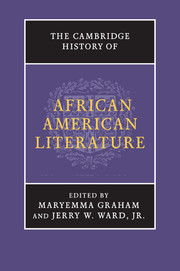Book contents
- Frontmatter
- Introduction
- PART I AFRICAN AMERICAN LITERATURE FROM ITS ORIGINS TO THE TWENTIETH CENTURY
- PART II AFRICAN AMERICAN LITERATURE IN THE TWENTIETH CENTURY
- 12 Foundations of African American modernism, 1910–1950
- 13 The New Negro Movement and the politics of art
- 14 African American literature and the Great Depression
- 15 Weaving jagged words: the black Left, 1930s–1940s
- 16 Writing the American story, 1945–1952
- 17 Geographies of the modern: writing beyond borders and boundaries
- 18 African American literature by writers of Caribbean descent
- 19 Reform and revolution, 1965–1976: the Black Aesthetic at work
- 20 History as fact and fiction
- 21 Redefining the art of poetry
- 22 Cultural resistance and avant-garde aesthetics: African American poetry from 1970 to the present
- 23 New frontiers, cross-currents and convergences: emerging cultural paradigms
- PART III AFRICAN AMERICAN LITERATURE AS ACADEMIC AND CULTURAL CAPITAL
- Bibliography
- Index
- References
20 - History as fact and fiction
from PART II - AFRICAN AMERICAN LITERATURE IN THE TWENTIETH CENTURY
Published online by Cambridge University Press: 28 May 2011
- Frontmatter
- Introduction
- PART I AFRICAN AMERICAN LITERATURE FROM ITS ORIGINS TO THE TWENTIETH CENTURY
- PART II AFRICAN AMERICAN LITERATURE IN THE TWENTIETH CENTURY
- 12 Foundations of African American modernism, 1910–1950
- 13 The New Negro Movement and the politics of art
- 14 African American literature and the Great Depression
- 15 Weaving jagged words: the black Left, 1930s–1940s
- 16 Writing the American story, 1945–1952
- 17 Geographies of the modern: writing beyond borders and boundaries
- 18 African American literature by writers of Caribbean descent
- 19 Reform and revolution, 1965–1976: the Black Aesthetic at work
- 20 History as fact and fiction
- 21 Redefining the art of poetry
- 22 Cultural resistance and avant-garde aesthetics: African American poetry from 1970 to the present
- 23 New frontiers, cross-currents and convergences: emerging cultural paradigms
- PART III AFRICAN AMERICAN LITERATURE AS ACADEMIC AND CULTURAL CAPITAL
- Bibliography
- Index
- References
Summary
Throughout its tenure on United States soil, African American literature has reflected a combination of History written with a capital “H” and history written in the lower case of everyday folk, that is, the masses of unlettered black folks for whom orality was the primary mode of cultural conveyance. Given the fact that many enslaved Africans were not allowed to learn to read and write, indeed that many states had laws forbidding such learning, it is not surprising that vibrant oral traditions developed among those who suffered through American bondage. Moreover, as Chapter 1 in this volume suggests, indigenous Africans derived from equally rich oral cultures on which they were forced to rely and upon which they could build. The space of oral narrative and folk arts and crafts became as much a part of African American history as academy-derived accounts of enslavement. From this perspective, African American folk traditions, both oral and those deriving from their interactions with the physical culture – such as quilting and basket-making – provide as much of the truth, that is, the history, of African American lives as any researched study. We can therefore speak of the factual history of oral tradition as persuasively as we speak of the factual History of researched/recorded/written traditions. As a people given to orality because of their circumstances in America, African Americans are thus heirs to dual histories, so to speak – that for the ear and that for the eye. When such orality influences written texts, it becomes eye for the ear while more fact-based Historical materials remain eye for the eye.
- Type
- Chapter
- Information
- The Cambridge History of African American Literature , pp. 451 - 496Publisher: Cambridge University PressPrint publication year: 2011
References
- 1
- Cited by



